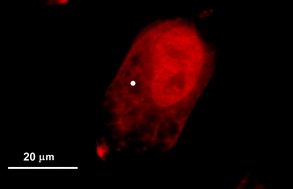Photosensitized production of singlet oxygen: spatially-resolved optical studies in single cells
Abstract
Singlet molecular oxygen, O2(a1Δg), can be created in photosensitized experiments with sub-cellular spatial resolution in a single cell. This cytotoxic species can subsequently be detected by its 1270 nm phosphorescence (a1Δg→ X3Σ−g). Cellular responses to the creation of singlet oxygen can be monitored using viability assays. Time- and spatially-resolved optical measurements of both singlet oxygen and its precursor, the excited state sensitizer, reflect the complex and dynamic morphology of the cell. These experiments help elucidate photoinduced, oxygen-dependent events that compromise cell function and ultimately lead to cell death. In this perspective, recent work on the photosensitized production and detection of singlet oxygen in single cells is summarized, highlighting the advantages and current limitations of this unique experimental approach to study an old problem.

- This article is part of the themed collection: Microscopy beyond imaging: space-resolved photochemistry and photobiology

 Please wait while we load your content...
Please wait while we load your content...